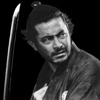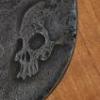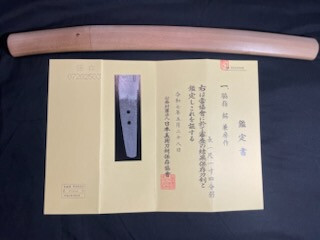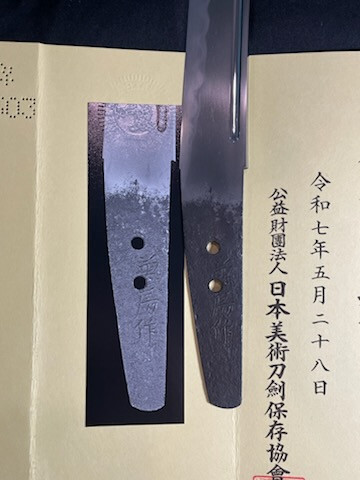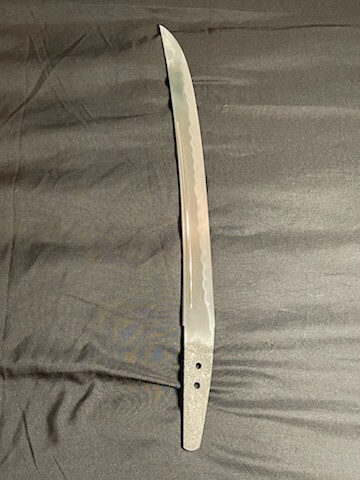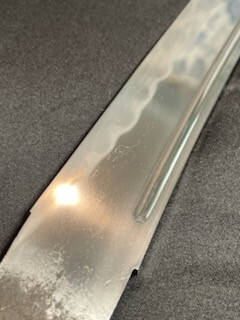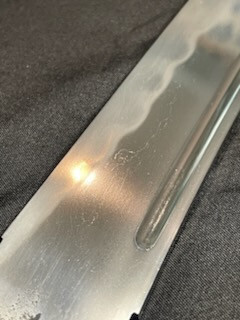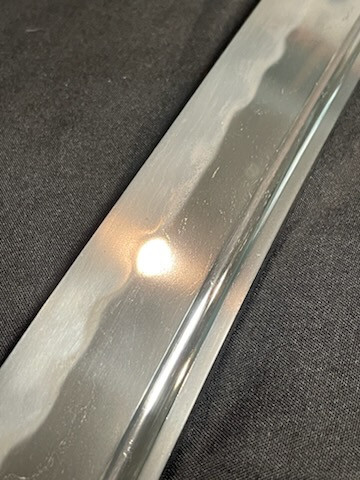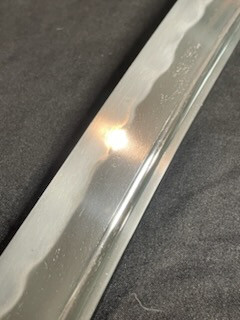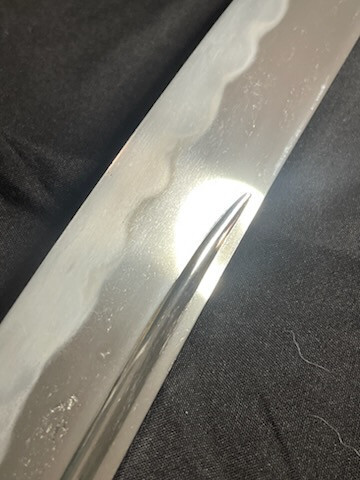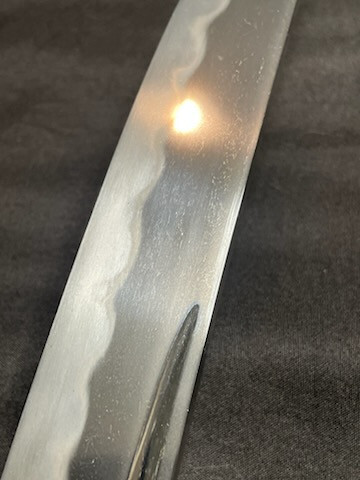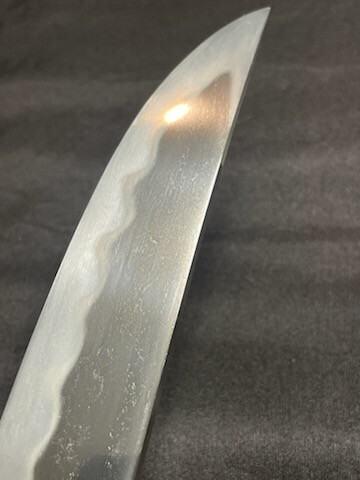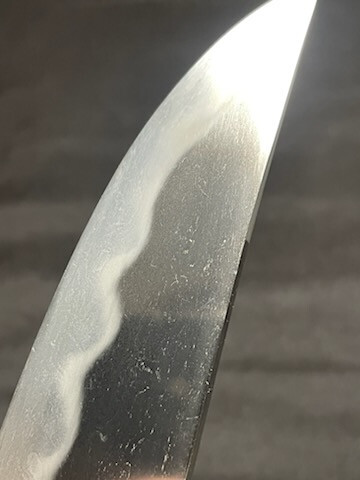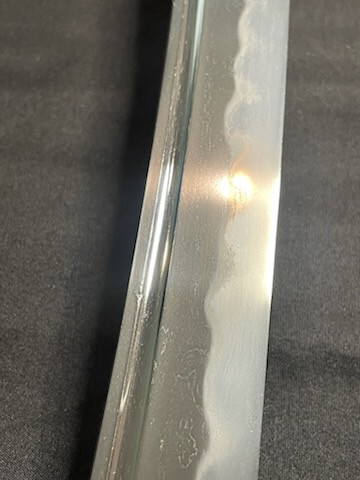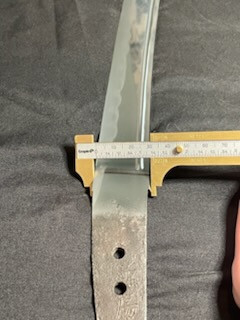
ChrisW
Members-
Posts
2,325 -
Joined
-
Last visited
-
Days Won
7
ChrisW last won the day on May 13 2024
ChrisW had the most liked content!
Profile Information
-
Location:
U.S., Indiana
-
Interests
Identifying and preserving antique blades
Profile Fields
-
Name
Chris W.
ChrisW's Achievements
-
As an early Thanksgiving/Black Friday special, I will keep the price at $2500 BUT include one of my hand-made makura (sword resting pillow) in a color of your choice (red, gold, purple, navy, sapphire, olive, forest, green) as well as FREE shipping/insurance within the continental US. If you are interested, but are outside of the continental US, we can easily work something out. This offer will only be good until Monday, December 1st.
-
I could see an argument for either, but having been dealing with a lot of Jumyo lately, I would agree that this looks like a Muromachi Jumyo den blade. The gunome/togari, the higaki yasurime, the longer nakago, and the styling of the boshi all point towards this. Early Kanemoto (2nd and later) lineage was a bit more formulaic with their sanbonsugi, which I am not seeing so much here; unless the wear is significant and the hamon has lost much of its original form. This might be a fun one to consider for Shinsa in my opinion! If you do pursue that, please let us know the results!
-
In an attempt to quicken this sale, I will go ahead and drop this blade to $2500 and no more than $500 in trade value, with $50 going to the board still. If you're looking for an early Kanefusa, this is a prime example of the second generation with the only comparable other example I've found being a 3rd generation in Koshirae for $3600! Obviously, the second generation is a lot more desirable and this blade's activity far outshines the comparable lesser 3rd generation example. The 3rd generation example is located in Japan, which entails all the waiting and possible headaches of tariffs as well. Mine is conveniently located in central US and will ship with minimal issues and wait times. Lastly, as a satisfied prior buyer of another item of mine pointed out, I make the transactions quick and simple. Shipping is handled post-haste with the utmost care for the item.
-
The Muromachi period is 1336 to 1573. Kirill believes it belongs to the Bizen school, which is one of the five major blacksmithing traditions in Japan. Kaga is a minor school, which does not belong to any of the five large schools. Utsuri is a secondary shadowy "hamon" that follows above the hamon itself and is usually a key point in attributing it to Bizen school in the Muromachi period typically. The hamon is the temperline that you're seeing on the body of the blade. It represents the hardened portion of the blade itself, from the edge to the wavy pattern you see in the body of the blade. The nakago reminds me of Kaga school blades, so my initial impression is that this is one of those.
-
Thank you for the compliment! I try to make sure that the listing, communication, and shipping is done the way I would want it to be done for me.
-
Hello ladies and gentlemen!, I am submitting this for sale here on the board. If it sells here, I'll pay $50 out of the final price to the board. Thanks again to Brian for providing a good platform for us sellers! Type (Tachi, Katana, Wakizashi, Tanto, Naginata, Other) : Ko-Wakizashi Ubu, Suriage or O-Suriage : Ubu Mei : (Mumei, Signature) : Signed sanji-mei Kanefusa Saku, two nakago-ana. Papered or not and by whom? : Hozon papered to 2nd Generation Kanefusa, by the NBTHK in 2024 Era/Age : Muromachi, approx. 1487-1528 Shirasaya, Koshirae or Bare Blade? : in nice, new shirasaya Nagasa/Blade Length : 34.5cm or 13.58 inches. Sori : 0.8cm (0.31 inches) Hamon Type : Kanefusa gunome-midare Jihada : Wide running itame, with course mokume elements. Lots of nie and some chikei present! Other Hataraki Visible : Ashi, sunagashi, kinsuji. Sharp kaeri that results in a Jizo statue appearance in the boshi. Flaws : brand new polish, only minor loose grain in a few spots that attest to its age. No openings, ware, or any other flaws visible. Sword Location : Indiana, USA Will ship to : USA primarily, international contingent on laws of destination country. Payment Methods Accepted : Paypal, Cashapp. Shipping options discussed at time of purchase. Price and Currency : $2600 USD or reasonable offers. Will only take up to $500 in trade value. Other Info and Full Description : Comes in new shirasaya with the original solid copper habaki. Will ship with a sword bag as well. This is a fantastic blade for sale at a great price. It is priced for a lot less than what you would see elsewhere. This is a scarce example of a ko-wakizashi by the 2nd generation Iwami no Kami Kanefusa, who is listed as a 3.5m yen smith in Toko-Taikan. He worked from approximately 1487 to 1528 and was son of Shodai Kanefusa. Their lineage is one of a few smith lineages that is considered unbroken and continues to this day in the 26th generation Kanefusa who makes fine cutlery. This particular example shows off a lot more activity than is typical for the later generations of this lineage, so there is a lot to study. It is not very often that such an early example of such a venerable lineage comes up for sale in such wonderful shape, so here is your chance! If interested, respond here and then direct message me!
-
World War II Sword, Maybe?
ChrisW replied to garbage finds's topic in General Nihonto Related Discussion
I wouldn't say its not an artifact. It is from WWII, which is still a good amount of time for something to survive. It certainly deserves care and respect. As for the cleaning of the tsuka, I would say its probably not safe to use isopropyl alcohol on the silk handle. I've never done it, so I am not sure. I will leave this up to my betters to respond to that query. -
World War II Sword, Maybe?
ChrisW replied to garbage finds's topic in General Nihonto Related Discussion
As Brian said! Also be sure to wipe in one direction in a singular swipe, do not do circular motions or back and forth as this will drag contaminants over the surface of the blade moreso than a singular swipe will. As for the isopropyl alcohol, look for 99.9% pure, do not buy any that is cut with water. -
$50 donated. Thanks to Brian and everyone!
-
Sword is sold! Please archive, thanks to everyone! I will be donating $50 to the board.
-
Reduced to $1800 for all 19, $300 will still go to the board if sold here.
-
Reduced to $1300 + shipping for quicker sale. A great chance to add a very beautiful koto omi yari with battle scars!



